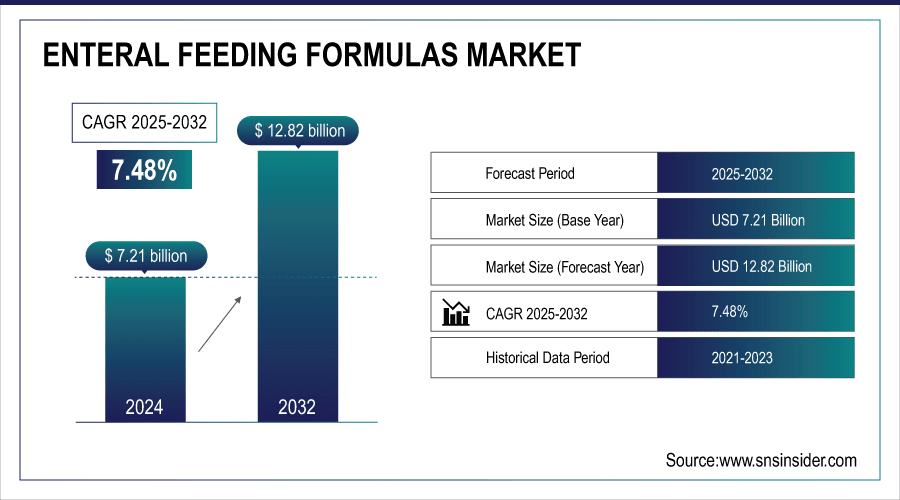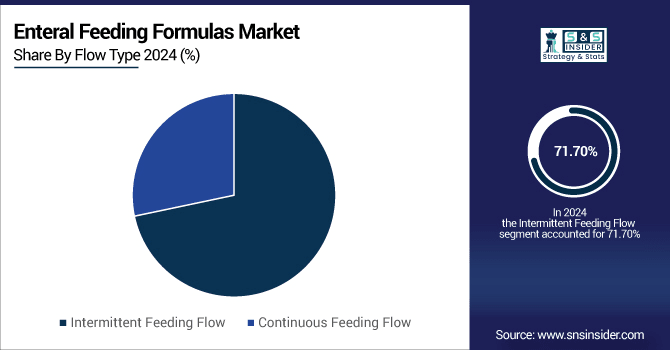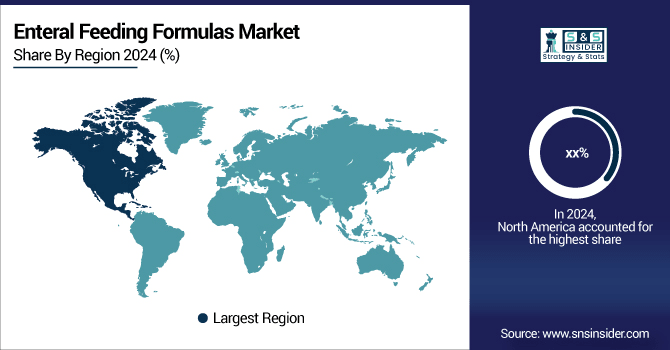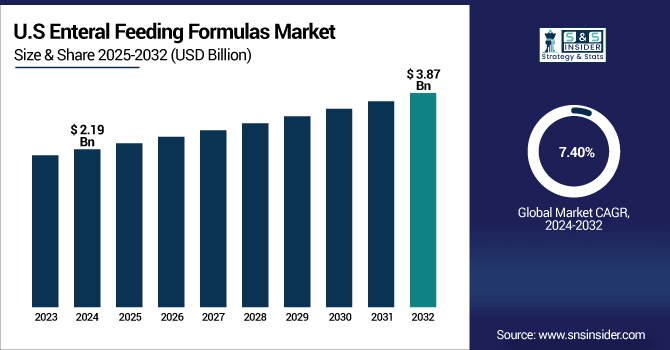Enteral Feeding Formulas Market Report Scope & Overview:
The Enteral Feeding Formulas Market size was valued at USD 7.21 billion in 2024 and is expected to reach USD 12.82 billion by 2032, growing at a CAGR of 7.48% over the forecast period of 2025-2032.
One of the key factors that has brought about the large-scale growth of the enteral feeding formulas industry is the global increase in chronic diseases. We see in conditions like cancer, diabetes, gastrointestinal issues, which include Crohn’s and short bowel syndromes, and neurological issues that include stroke, ALS, and Parkinson’s, that many patients’ ability to eat normally is impaired, and they, in turn, require nutritional support via enteral feeding. As we see the incidence and prevalence of these issues go up, which is a result of aging populations, poor diet, and low activity levels, more patients are coming to terms with long-term and disease-specific enteral nutrition in both the hospital and at-home settings.
For instance, according to NIH 2024, 2,001,140 new cancer cases and 611,720 cancer deaths are projected to occur in the United States. Cancer mortality continued to decline through 2021.

To Get More Information On Enteral Feeding Formulas Market - Request Free Sample Report
Market Size and Forecast:
-
Market Size in 2024: USD 7.21 Billion
-
Market Size by 2032: USD 12.82 Billion
-
CAGR: 7.48% from 2025 to 2032
-
Base Year: 2024
-
Forecast Period: 2025–2032
-
Historical Data: 2021–2023
Enteral Feeding Formulas Market Trends
-
Scientific innovations and nutritional therapy expansion by experts enhance formula reliability and patient confidence.
-
Online channels and medical influencers boost knowledge of feeding solutions, fostering broader acceptance.
-
Introduction of advanced compositions, administration techniques, and dietary protocols widens utilization across diverse conditions.
-
Partnerships, supply frameworks, and caregiver-support initiatives increase accessibility and global availability.
-
Continuous evaluations to optimize performance, tolerance, and safety encourage sustained adoption and clinical integration worldwide.
Enteral Feeding Formulas Market Growth Drivers:
-
Product Innovation and Personalization are the Major Drivers of the Enteral Feeding Formulas Market Growth
The constant innovation and personalization of nutritional products being tailored to the precise health conditions of a wide range of patients is one of the most significant factors driving the growth of the enteral feeding formula market analysis. In the past, general nutrition support was provided with standard formulas, but now disease-specific or condition-targeted formulas are increasingly requested. Furthermore, the market space has shown increasing interest in blenderized or wholefood-based formulas, particularly within the pediatric and home care environment, due to the patient or caregiver preference for more “natural” ingredients. This individualization not only leads to better results in treatment but also a rise in compliance of patient.
For instance, according to Abbott Proconnect, Peptide is a specialized nutrition to support gastrointestinal (GI) tolerance. It is calorie-dense with hydrolysed protein. It is suitable as a sole source of nutrition or as a supplement to be used under medical advice.
Enteral Feeding Formulas Market Restraints:
-
Lack of Awareness Among Patients and Caregivers is Restraining the Enteral Feeding Formulas Market Growth
The lack of awareness about the disease state and malnutrition, not only among patients and caregivers, but also among some healthcare professionals (particularly in underdeveloped and non-hospital practice settings), is one of the major impediments to the overall growth of the enteral feeding formulas market. Most of the patients and their families are not aware of the possibility of using enteral nutrition as a medical treatment, mainly at home or in chronic situations, such as cancer, stroke, and neurological diseases. This results in reluctance or fear of using feeding tubes, misinterpreting the safety of long-term enteral feeding, or indecision about when and how to begin it.
Enteral Feeding Formulas Market Segmentation Analysis
By Flow Type
In 2024, the Intermittent Feeding Flow segment dominated the Enteral Feeding Formulas Industry with a 71.70% market share. Intermittent Feeding Flow Intermittent Feeding Flow is the leading enteral feeding formula as it more closely emulates the body's normal eating patterns and delivers both physiological and functional benefits. It is different from continuous feeding, which slowly delivers nutrition over 24 hours, and provides nutrition in specific intervals like regular meals, preserving regular digestive function, promoting patient comfort, and possibly reducing feeding intolerance, such as bloating or diarrhea. This technique is particularly useful in home care, rehab, and skilled-nursing-care patients who are somewhat more ambulatory and independent.
The Continuous Feeding Flow is emerging as the fastest growing segment in the Enteral Feeding Formulas share, with the highest CAGR of 8.18%. Because it has been more widely used in critical care, ICUs, and on long-term hospitalized patients needing a stable, controlled nutrition. Continuous mechanized feeding. Continuous feeding allows nutrients to slowly and continuously flow into the digestive tract around the clock and is especially helpful in patients with severe gastrointestinal dysfunction, low tolerance to bolus feeding, or high risk of aspiration. It is widely used in the acute care setting because it improves nutrient utilization, decreases the risk of metabolic complications, and improves blood glucose levels, particularly in the critically ill or post-operative patient.

By Product
Standard Formulas were the dominant segment in the global Enteral Feeding Formulas Market, with a 48.64% market share in 2024. Due to its broad utility, cost-effectiveness, and availability in a variety of health care environments. These products are nutritionally complete and can be used for all ages and stages, whether a person has no specific medical or nutrition requirements or if they require a specific disease-related nutrition treatment plan based on their medical diagnosis. The new article is aimed at formulas as frontline treatment, in hospitals and long-term care, and even sometimes at home, for people who are recovering from surgery or illness, or who are mildly malnourished. Given their more cost-effective nature compared with specialised formulas, those products are especially appealing in cost-constrained markets and contexts focusing on the poor and disadvantaged.
Disease-specific Formulas play a very important role in the Enteral Feeding Formulas Market growth, as it is the fastest-growing segment with a CAGR of 8.05%. The worldwide burden of chronic and complex diseases, including cancer, diabetes, kidney disease, liver disease, neurological disorders, and gastrointestinal diseases, is growing. Standard formulas may not be able to meet the unique nutritional needs of these patient populations. As a consequence, there is an increasing preference on the market for customized nutritional solutions that will support the response to treatment, promote nutrient uptake, and lower the risk of complications, malnutrition, or intolerance.
By Stage
The adult segment held a significant market share of 76.36% of the global Enteral Feeding Formulas industry in 2024, as adults—particularly the elderly—represent the majority of the population in need of circadian-dosed long-term nutritional support for chronic diseases, surgeries, and age-related conditions.” Diseases such as cancer, stroke, neurological, gastroenterological, and diabetic (endocrinologic) disorders are much more common in adults, the elderly in particular, for whom there is a risk of not being able to satisfy their nutritional needs with ordinary food by mouth. And the graying of the world is going a long way toward ensuring its continued dominance. Adults are also the dominant consumers of disease-specific, peptide-based, and immune-modulating formulas, which are generally used more for adult health concerns than for children.
The adult segment is projected to be the fastest-growing segment in the enteral feeding formulas market trend owing to the increasing incidence of chronic and lifestyle diseases, as cancer, diabetes, neurological diseases, gastrointestinal disorders, and kidney diseases, which are extremely common in the adult population, particularly in individuals aged 40 and above. With the ongoing increase in global life expectancy, the population of adults living with chronic conditions has risen, conditions that often either prevent or impair their ability to ingest and/or absorb (solely) nutritionally balanced diets by mouth.
By Application
Oncology is the leading segment in the enteral feeding formulas market analysis, with a 32.80% market share, for the fact that cancer patients, particularly those who are receiving chemotherapy, radiation, or surgery, frequently experience malnutrition, dysphagia (difficulty swallowing), anorexia (decrease in appetite), and gastrointestinal side effects that limit their ability to take in and absorb nutrients through their normal oral intake. In several instances, enteral nutrition is essential to provide sufficient calories and protein in the course of therapy and during the recuperation phase.
The Diabetes segment is the fastest growing in the Enteral Feeding Formulas Market trend in the context of a growing epidemic of diabetes worldwide, especially type 2 diabetes in the elderly, and Lifestyle-related factors such as obesity and poor diet. Many diabetics have particular nutritional needs, particularly when they are hospitalized, recuperating from an operation, or have complications such as neuropathy or kidney disease that interfere with normal eating. Healthcare professionals are more and more prescribing diabetes-specific enteral formulas, low in carbohydrates, with a low glycemic index, high in fiber, and healthy fats to limit glycemic variations in these patients.
By End user
The hospital has the largest share of the Enteral Feeding Formulas Market, at 52.54% market share, since those patients represent the real target for acute, critical, or postoperative care who need rapid and adjusted nutritional support. Many patients admitted for trauma, stroke, cancer treatment, gastrointestinal surgery, or in the ICUs may lose their ability to eat normally after being hospitalized and are put on enteral nutrition to keep or restore their nutritional state. Hospitals have the structure, staff, and tracking systems to safely provide enteral feeding via feeding tubes and advanced infusion devices.
Other segments are the fastest-growing segment of the Enteral Feeding Formulas Market, nursing homes, rehab centers, ambulatory care, and outpatient settings. It is the largest and fastest-growing application in the enteral feeding formulas market, as there is a worldwide trend of providing cost-effective (home care), personalized, and home-based health care. Since COVID-19, HEN has intensified because hospitals need to clear inpatient beds and patients want to convalesce in familiar, home-based, cheaper surroundings. The trend is also propelled forward with the advancement in portable enteral feeding pumps, user-friendly formula containers, as well as tele-health supported nutrition surveillance, to help improve the safety and access to home palatable blend administration.
Enteral Feeding Formulas Market Regional Analysis:
North America Enteral Feeding Formulas Market Insights
In 2024, the North American region holds a significant market share in the Enteral Feeding Formulas industry, as a result of good healthcare systems, high chronic disease prevalence, and well-established subsidies of medical nutrition. The population, especially in the United States, has a high incidence of people with illnesses like cancer, diabetes, neurological maladies, medical conditions involving the gastrointestinal tract, and post-surgical problems that all require enteral feeding, even if just to facilitate the process of recovering from treatment.
Also, the timely introduction of medical nutrition practices and accessibility of disease-specific and peptide-based formulas from top industry players such as Abbott, Nestlé Health Science, and Kate Farms additionally contribute to market leadership. The area has also experienced a significant trend toward home enteral nutrition (HEN) backed by well-functioning insurances (e.g., Medicare/Medicaid), telerehabilitation services, and professional home care setup.

U.S. Enteral Feeding Formulas Market Insights
The U.S. Enteral Feeding Formulas Market was valued at USD 2.19 billion in 2024 and is expected to reach USD 3.87 billion by 2032, growing at a CAGR of 7.40% from 2025-2032.

Get Customized Report as Per Your Business Requirement - Enquiry Now
The U.S. has had a large transition from hospital-based to home-based nutrition therapy, especially since the pandemic of COVID-19. As healthcare costs increase and patients prefer recovering at home, Home Enteral Nutrition (HEN) programmes have developed as an important component of post-acute care. A reimbursement mechanism with clearly defined pathways, integral home health care services, and monitoring via telehealth can help facilitate patients with chronic or long-term conditions who may need enteral support to receive their nutrition at home. This trend has prompted a growing request for ready-to-use formulas, portable feeding platforms, and blended options that are easier to use in a home setting. And the HEN movement is getting a boost from Medicare and private insurers that are cutting reimbursements and, for some services, tying payment to outcomes.
Europe Enteral Feeding Formulas Market Insights
Europe Enteral Feeding Formulas Market Europe commands the second largest market share in the enteral feeding formulas market, on account of well-established health systems, sets of strong clinical nutrition guidelines, and an aging population, thus increasing the need for long-term and disease-specific nutritional support. Nations such as Germany, France, the UK, and Italy have a high prevalence of chronic diseases, including cancer, diabetes, gastrointestinal, and neurological diseases that necessitate enteral feeding, particularly in elderly or post-acute care patients. Numerous key international and regional players, such as Danone Nutricia, Nestlé Health Science, and Fresenius Kabi, which are based in Europe or highly active in the region, lead to high product market availability and innovation according to local demand. Furthermore, European nations have established financial reimbursement schemes and national health services that offer enteral nutrition in hospital and home care, resulting in more widespread adoption.
Asia-Pacific Enteral Feeding Formulas Market Insights
Asia-Pacific is the fastest-growing region in the enteral feeding formulas market, with a CAGR of 8.11%, due to a combination of demographic, economic, and healthcare-related factors that are rapidly transforming the region’s medical nutrition landscape. First, the region is experiencing a rapid rise in chronic diseases such as cancer, diabetes, stroke, and gastrointestinal disorders, fueled by aging populations, urbanization, and lifestyle changes. Countries like China, India, and Japan have some of the world’s largest elderly populations, which significantly increases the need for long-term enteral nutrition in hospitals, nursing homes, and home settings.
Second, healthcare infrastructure and awareness are improving across both developed and emerging Asia-Pacific countries. Governments and private sectors are investing more in critical care, rehabilitation, and home-based medical services, which are expanding access to enteral feeding therapies beyond hospitals. Third, rising healthcare spending, growing medical tourism, and greater adoption of clinical nutrition protocols are pushing hospitals and clinicians in the region to adopt advanced, disease-specific, and personalized enteral formulas.
Latin America (LATAM) and Middle East & Africa (MEA) Enteral Feeding Formulas Market Insights
The Middle East & Africa account for a smaller share in the enteral feeding formulas market owing to various structural, economic, and healthcare-related challenges in the region, which restrict the market growth in the region. For a start, access to state-of-the-art healthcare systems is relatively restricted in a lot of countries in this part of the world, particularly in rural and underprivileged areas. Enteral feeding demands clinical oversight, trained people and medical technology, resources that are frequently missing or sporadically available in some parts of Africa and the Middle East. Secondly, there is a low level of awareness and education about the significance of clinical nutrition and the correct utilization of enteral feeding formulas. Very frequently, malnourished or chronically ill patients are not given enteral nutrition because their physicians do not know much about such practices, have had inadequate professional training, or follow local policy decisions.
The Enteral Feeding Formulas Market Trend in Latin America offers a modest albeit expanding opportunity led by slow gains in healthcare access, increased knowledge of clinical nutrition, and mounting prevalence of chronic diseases like cancer, diabetes, and gastrointestinal disorders. Brazil, Mexico, Argentina, and Chile are the most important countries in the region, with greater availability of hospitals and nutritional support services in the urban pockets of these countries. With the modernization of many healthcare services and public health efforts by governments focusing on nutrition deficiency and chronic disease management, the demand for tube feeding, namely in hospitals and long-term care facilities, is increasing. There is also increasing interest in home enteral nutrition (HEN), particularly in private practice and middle- to higher-income patients.
Enteral Feeding Formulas Market Key Players:
Some of the Enteral Feeding Formulas Market Companies are:
-
Abbott
-
Danone SA
-
Fresenius Kabi
-
Nestlé
-
Victus, Inc.
-
Primus Pharmaceuticals, Inc.
-
Meiji Holdings Co., Ltd
-
Reckitt Benckiser Group Plc
-
Medline Industries, LP
-
Hormel Health Labs
-
B. Braun Melsungen AG
-
Baxter International Inc.
-
Kate Farms, Inc.
-
Mead Johnson Nutrition
-
Real Food Blends
-
Nutritional Designs, Inc.
-
Global Health Products, Inc.
-
Nutricia
-
Cambrooke Therapeutics, Inc.
-
Fresenius SE & Co. KGaA
-
Nualtra Ltd.
-
Ajinomoto Co., Inc.
-
Nestlé Health Science
-
Avanos Medical, Inc.
-
Abbott Nutrition
-
Hormel Foods Corporation
-
NutriMedical BV
-
Nutrivitalia Srl
Enteral Feeding Formulas Market Competitive Landscape:
Fresenius Kabi, founded in 1999 and headquartered in Bad Homburg, Germany, is a global healthcare company specializing in lifesaving medicines and technologies for infusion, transfusion, and clinical nutrition. The company offers a broad portfolio of enteral and parenteral nutrition products, injectable drugs, and medical devices, serving hospitals and healthcare providers worldwide.
- In February 2025, Fresenius Kabi Expands Enteral Nutrition Manufacturing in Asia-Pacific. Opened a new production facility in Malaysia to improve supply chain resilience and meet growing demand in Asia-Pacific.
Danone SA is a multinational food and beverage company specializing in dairy products, plant-based alternatives, early life nutrition, and medical nutrition solutions. Founded in 1919 in Barcelona, Spain, it is now headquartered in Paris, France. The company emphasizes health-focused innovation, sustainability, and global outreach to improve nutrition and well-being worldwide.
- On January 9, 2024, Danone and Resilience partnered to develop the first of its kind nutrition and oncology module that is now integrated in Resilience’s digital oncology solution.
| Report Attributes | Details |
|---|---|
| Market Size in 2024 | USD 7.21 billion |
| Market Size by 2032 | USD 12.82 billion |
| CAGR | CAGR of 7.48% From 2025 to 2032 |
| Base Year | 2024 |
| Forecast Period | 2025-2032 |
| Historical Data | 2021-2023 |
| Report Scope & Coverage | Market Size, Segments Analysis, Competitive Landscape, Regional Analysis, DROC & SWOT Analysis, Forecast Outlook |
| Key Segments | • By Product (Standard Formulas, Disease-specific Formulas, Peptide Based, Immune modulating, Blenderized) •By Flow Type (Intermittent Feeding Flow, Continuous Feeding Flow ) • By Stage (Adults, Pediatrics) •By Application(Oncology. Gastrointestinal Diseases, Neurological Disorders, Diabetes, Other Applications) •By End user(Hospital, Long-term Care Facilities, Others)" |
| Regional Analysis/Coverage | North America (US, Canada, Mexico), Europe (Germany, France, UK, Italy, Spain, Poland, Turkey, Rest of Europe), Asia Pacific (China, India, Japan, South Korea, Singapore, Australia, Rest of Asia Pacific), Middle East & Africa (UAE, Saudi Arabia, Qatar, South Africa, Rest of Middle East & Africa), Latin America (Brazil, Argentina, Rest of Latin America) |
| Company Profiles | Abbott, Danone SA, Fresenius Kabi, Nestlé, Victus, Inc., Primus Pharmaceuticals, Inc., Meiji Holdings. Co., Ltd, Rickett Benckiser Group Plc, Medline Industries, LP, and Hormel Health Labs. |

